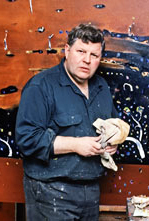
Click an Image below to Enlarge

Fred Williams knew from an early age he was an artist. In 1945, at the age of 16, he commenced fulltime education at the National Gallery School in Victoria. He sought additional tutelage under George Bell, who provided alternative to the structure and formality of the Gallery School. He left Australia in 1951 to continue his studies at Chelsea Art School, and painted predominately figurative works during his 6 year stint in the UK and Europe.
Williams returned from overseas in 1957 and was at odds with his contemporaries who had forged a collective reputation as the Antipodeans. The Australian bush presented a worthwhile muse and he went to work interpreting it.
The paintings he produced in the late 1950s are magnified, layered works: close up tree trunks and delicate saplings entwine. In these early landscapes, we get glimpses of Williams’ rediscovery of Australia and his obsession with composition. The latter was to become the artist’s watermark – his signature and invaluable contribution to our interpretation of the Australian landscape.
During the 1960s Williams conducted regular day trips from his Melbourne home (in South Yarra) painting in and around the Dandenong’s, eventually relocating his family to the area. The canvases he produced during this period provided us with a distant perspective of the landscape. Williams incorporated a high horizon line with thin strips of sky and the bush is abstract and ethereal. This is considered a period of tremendous invention and productivity and key works have sold for millions of dollars at auction.
In 1968 severe bush fires ravaged the Dandenong Ranges. The fires came within a hundred metres of Fred Williams Upwey home and made a lasting impression on the artist. As soon as the embers had cooled, he returned to his easel and worked through the challenge of painting a charred and minimal landscape. In addition to producing a series of sublime minimal works, he played with technique and started using gouache on paper. This medium enabled him to become more expressive and resulted in a radical shift of format. Williams now oscillated between painting horizontal and vertical landscapes and explored new subjects and territory.
During the 1970s Williams painted seascapes, waterfalls, ravines but always returned to his favoured subject: Victoria’s landscapes. In works such as the ‘Avenel' Landscapes, we get an insight into William’s mastery of gouache on paper medium. Lower horizon lines quite literally open the viewer to the sky. Looser and more whimsical application of material relay a less hostile and less intimidating interpretation of landscape. The shift is significant from the dense, hard works he painted in the late 1950s. Works from this period received are highly sought after and resulted in several large commissions, including the prized Pilbara series completed in 1979. This series was acquired by Rio Tinto and subsequently gifted to the National Gallery of Victoria.
Fred Williams died in 1981 aged 55. Critically and commercially acclaimed as one of Australia’s greatest 20th century landscape painters, his contribution to Australian art was aptly summarised by friend and peer John Brack who delivered the following eulogy at his funeral:
He changed the way we see our country: an achievement which will live long after all of us are gone.
Copyright © 2007 Abstract Australis. All rights reserved. Click here to view copyright statement